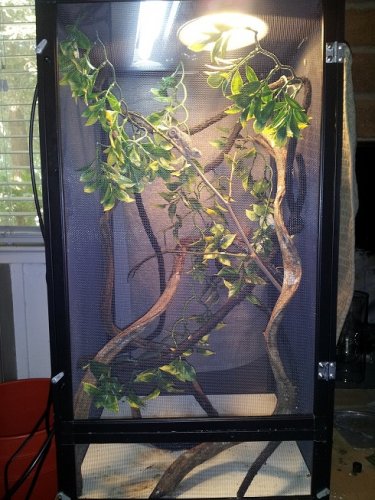Hi there,
I am considering purchasing a chameleon. I have been researching and trying to sort out the proper set-up. It is a bit daunting because everyone has a different opinion.
I've seen it said that you can't put a young chameleon in a large mesh enclosure and I've seen it said that it is better to put the chameleon in the same enclosure that you will use when he/she is an adult because changing habitats can be extremely stressful.
I've seen various advice on what is best to feed chameleons (in addition to crickets). Some say that mealworms are best, some say wax worms, some say butterworms. I've also heard that they need a more diverse insect diet than worms and crickets. Also, the smallest quantity of crickets that I am finding is 500. I read that 8-10 small crickets are recommended for a small chameleon and that you should not have more than a 2 week supply. The math on that would be 100-140 crickets. Where can I purchase this smaller quantity?
I plan to put a ficus and a hibiscus in my chameleon's habitat. Is that sufficient?
I know that spinach and broccoli aren't recommended. What leafy greens and fruits does your chameleon enjoy?
Lastly...a friend of ours has a reptile. She does not have a complex misting system. She has a spray bottle. How hardcore do we need to go with the misting? Several times a day for at least 5 minutes is the rule that I heard. Does it matter if that is via a system or by hand?
I'd appreciate any opinions that anyone wants to offer. We want a happy, healthy pet.
ETA: I've also seen various recommendations for bedding in the bottom of the enclosure. One person said that she uses pine chips. We used to have a snake and pine chips were NOT recommended for a reptile because they may have mites that can make the animal sick. I've heard of people using sand but saw that the calcium enriched sand that pet suppliers sell is not recommended - why not? Someone else recommended newsprint but I would think that there would be toxins in the ink that could be harmful. Thoughts?
I am considering purchasing a chameleon. I have been researching and trying to sort out the proper set-up. It is a bit daunting because everyone has a different opinion.
I've seen it said that you can't put a young chameleon in a large mesh enclosure and I've seen it said that it is better to put the chameleon in the same enclosure that you will use when he/she is an adult because changing habitats can be extremely stressful.
I've seen various advice on what is best to feed chameleons (in addition to crickets). Some say that mealworms are best, some say wax worms, some say butterworms. I've also heard that they need a more diverse insect diet than worms and crickets. Also, the smallest quantity of crickets that I am finding is 500. I read that 8-10 small crickets are recommended for a small chameleon and that you should not have more than a 2 week supply. The math on that would be 100-140 crickets. Where can I purchase this smaller quantity?
I plan to put a ficus and a hibiscus in my chameleon's habitat. Is that sufficient?
I know that spinach and broccoli aren't recommended. What leafy greens and fruits does your chameleon enjoy?
Lastly...a friend of ours has a reptile. She does not have a complex misting system. She has a spray bottle. How hardcore do we need to go with the misting? Several times a day for at least 5 minutes is the rule that I heard. Does it matter if that is via a system or by hand?
I'd appreciate any opinions that anyone wants to offer. We want a happy, healthy pet.
ETA: I've also seen various recommendations for bedding in the bottom of the enclosure. One person said that she uses pine chips. We used to have a snake and pine chips were NOT recommended for a reptile because they may have mites that can make the animal sick. I've heard of people using sand but saw that the calcium enriched sand that pet suppliers sell is not recommended - why not? Someone else recommended newsprint but I would think that there would be toxins in the ink that could be harmful. Thoughts?

